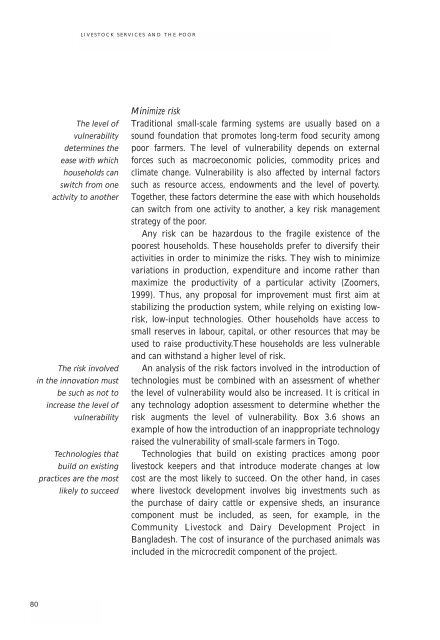Livestock Services and the Poor: A global initiative - IFAD
Livestock Services and the Poor: A global initiative - IFAD
Livestock Services and the Poor: A global initiative - IFAD
You also want an ePaper? Increase the reach of your titles
YUMPU automatically turns print PDFs into web optimized ePapers that Google loves.
80<br />
The level of<br />
vulnerability<br />
determines <strong>the</strong><br />
ease with which<br />
households can<br />
switch from one<br />
activity to ano<strong>the</strong>r<br />
The risk involved<br />
in <strong>the</strong> innovation must<br />
be such as not to<br />
increase <strong>the</strong> level of<br />
vulnerability<br />
Technologies that<br />
build on existing<br />
practices are <strong>the</strong> most<br />
likely to succeed<br />
LIVESTOCK SERVICES AND THE POOR<br />
Minimize risk<br />
Traditional small-scale farming systems are usually based on a<br />
sound foundation that promotes long-term food security among<br />
poor farmers. The level of vulnerability depends on external<br />
forces such as macroeconomic policies, commodity prices <strong>and</strong><br />
climate change. Vulnerability is also affected by internal factors<br />
such as resource access, endowments <strong>and</strong> <strong>the</strong> level of poverty.<br />
Toge<strong>the</strong>r, <strong>the</strong>se factors determine <strong>the</strong> ease with which households<br />
can switch from one activity to ano<strong>the</strong>r, a key risk management<br />
strategy of <strong>the</strong> poor.<br />
Any risk can be hazardous to <strong>the</strong> fragile existence of <strong>the</strong><br />
poorest households. These households prefer to diversify <strong>the</strong>ir<br />
activities in order to minimize <strong>the</strong> risks. They wish to minimize<br />
variations in production, expenditure <strong>and</strong> income ra<strong>the</strong>r than<br />
maximize <strong>the</strong> productivity of a particular activity (Zoomers,<br />
1999). Thus, any proposal for improvement must first aim at<br />
stabilizing <strong>the</strong> production system, while relying on existing lowrisk,<br />
low-input technologies. O<strong>the</strong>r households have access to<br />
small reserves in labour, capital, or o<strong>the</strong>r resources that may be<br />
used to raise productivity.These households are less vulnerable<br />
<strong>and</strong> can withst<strong>and</strong> a higher level of risk.<br />
An analysis of <strong>the</strong> risk factors involved in <strong>the</strong> introduction of<br />
technologies must be combined with an assessment of whe<strong>the</strong>r<br />
<strong>the</strong> level of vulnerability would also be increased. It is critical in<br />
any technology adoption assessment to determine whe<strong>the</strong>r <strong>the</strong><br />
risk augments <strong>the</strong> level of vulnerability. Box 3.6 shows an<br />
example of how <strong>the</strong> introduction of an inappropriate technology<br />
raised <strong>the</strong> vulnerability of small-scale farmers in Togo.<br />
Technologies that build on existing practices among poor<br />
livestock keepers <strong>and</strong> that introduce moderate changes at low<br />
cost are <strong>the</strong> most likely to succeed. On <strong>the</strong> o<strong>the</strong>r h<strong>and</strong>, in cases<br />
where livestock development involves big investments such as<br />
<strong>the</strong> purchase of dairy cattle or expensive sheds, an insurance<br />
component must be included, as seen, for example, in <strong>the</strong><br />
Community <strong>Livestock</strong> <strong>and</strong> Dairy Development Project in<br />
Bangladesh. The cost of insurance of <strong>the</strong> purchased animals was<br />
included in <strong>the</strong> microcredit component of <strong>the</strong> project.

















